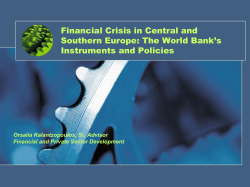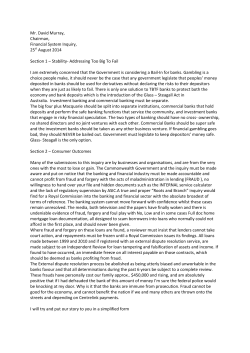
Document 396174
THURSDAY, OCTOBER 30, 2014 BUSINESS IMF calls for sweeping reforms in GCC KAMCO Investment Research Report KUWAIT: In its latest regional economic outlook on MENA Region, IMF has indicated that despite setbacks, an uneven global economic recovery continues. According to the IMF, the growth forecast for the world economy has been revised downward to 3.3 percent this year, 0.4 percentage point lower than in the April 2014 World Economic Outlook largely due to weaker-than-expected global activity in the 1H-2014. Economic developments in the MENA Region continue to reflect the diversity of conditions prevailing across the region. Most high-income oil exporters, primarily in the GCC, continue to record steady growth and solid economic and financial fundamentals, albeit with medium-term challenges that need to be addressed. In the non-GCC countries, improving the political and business environment, addressing infrastructure bottlenecks, and enhancing access to finance are important prerequisites for raising investment, productivity, and sustained growth. GDP growth in the GCC region is expected to improve in 2014 to reach 4.4 percent after seeing healthy growth of 4.1 percent in 2013 as per IMF estimated figures. Growth remains steady in most of the GCC countries on the strength of public spending on infrastructure and private sector credit expansion in many countries. Despite the regional issues, in addition to the huge drop in oil prices, IMF upgraded its GDP growth forecast for Saudi Arabia, the region’s largest economy to reach 4.6 percent in 2014 compared to the previous estimates of 4.1 percent for the same year in May 2014. The outlook of Qatar economy upgraded from a growth rate of 5.9 percent estimated in May-14 to 6.5 percent in October for 2014, the highest Growth among its peers in the GCC Region. The IMF estimates Kuwait’s growth rate to be 1.4 percent a sharp decline from the May estimate of 2.6 percent. MENA region According to IMF, Economic developments in the MENA countries continue to reflect the diversity of conditions prevailing across the region. Most high-income oil exporters, primarily in the GCC, continue to record steady growth and solid economic and financial fundamentals, albeit with mediumterm challenges that need to be addressed. In contrast, other countries — Iraq, Libya, and Syria — are mired in conflicts. And yet other countries, mostly oil importers, are making continued but uneven progress in advancing their economic agendas, often in tandem with political transitions and amidst difficult social conditions. In most of these countries, without extensive economic and structural reforms, economic prospects for the medium term remain insufficient to reduce high unemployment and improve living standards. Economic activity in the MENA oilimporting countries has remained lackluster this year at about 3 percent, but growth is expected to pick up to 4 percent in 2015 (broadly unchanged from the May 2014 Update). GCC economies need reforms In the GCC economies, the need is to strengthen their fiscal positions by using the current period of economic strength to save more of their oil windfall. IMF has suggested that most oil exporters also need to adapt their economic model for more sustained, inclusive, and diversified growth. The country’s financial fiscal model has been dependent on the growth of government spending supported by increases in oil prices. Transitioning to a more diversified, private sector-driven model requires significant reform. In the GCC countries, the business environment is generally favorable and infrastructure gaps are small. So the reform priorities should center on improving the quality of education and its relevance for private sector needs; reducing distortions that lead to reliance on foreign labor, thereby increasing private sector job opportunities for nationals; and encouraging efficient production of tradable goods and services rather than activity in non-tradable sectors with low productivity growth. We believe that the inflation situation in the GCC economies will continue to be benign as reflected from the IMF data and projection. However, any further decline in oil prices will have an effect on their fiscal balance and current account balance. Although the current oil prices (above $80 per barrel) are above the breakeven prices of most countries, however the high expenditures especially the current expenditure can be a cause of concern in future if the oil prices remain depressed or if the oil exporters take production cuts. What GCC requires is more diversification of their economies which they are looking at seriously through various projects and using oil surplus to spur the nonoil sector which is being seen in the strong growth in the non-oil sector in these economies albeit on a lower base and scale. In the GCC, the business environment is favorable by international standards, infrastructure gaps are small, and the efficiency of high capital spending is comparable with that in other countries. However, IMF suggests some more measure to build on the progress which includes improving education quality, restraining growth in public wage bills and incentivizing GCC men and women to seek private sector jobs, reducing distortions that lead to excessive reliance on foreign labor, gradually reducing energy subsidies and reorienting incentives toward tradable sectors. It will also help in tackling another challenge that the GCC region faces which is to create jobs for the young population which will be joining the workforce in the near future. Oil price decline a major risk factor Oil prices needs to be watched out for as higher-than-expected oil supply from other regions (for example, the United States) or lower global oil demand, owing to weaker global economic growth, could also further ease oil markets. As per IMF, oil prices, as well as regional security conditions, are also important sources of risk for activity in the non-oil economy. ECB says banking sector continuing to heal, slowly Demand for bank loans pick up LONDON: BP Group Chief Executive Bob Dudley addresses delegates during the Oil and Money conference in central London yesterday. —AFP Gold steadies as investors expect cautious Fed stance LONDON: Gold steadied near $1,230 an ounce yesterday as investors awaited guidance from the US Federal Reserve, widely expecting it to reaffirm willingness to wait for an extended period before raising interest rates. The Fed, which wraps up a two-day policy meeting later yesterday, is widely expected to end its two-year-old bond-buying stimulus, known as quantitative easing, as the US economy gathers momentum. Fed officials have also stressed, however, that they are in no hurry to take tightening a step further by raising rates from near zero levels, citing subdued inflation and the poor quality of a recovery in labor markets. Gold has benefited from the low interest rates and increased liquidity that have dominated central bank policy in the years after the 2008 financial crisis. Keeping US interest rates lower for a longer period bodes well for a non-interest bearing asset such as gold. Spot gold was unchanged at $1,228.00 an ounce by 1045 GMT after edging higher on Tuesday. The metal reached a six-week high of $1,245 last week. US gold futures were down $2.50 an ounce at $1,227.00. “This should be the end of QE, but if some wording is used by the Fed that the economic recovery doesn’t justify removal of its monetary stimulus and they have ... to leave the door open to reinstating some measures in the future, then that could be interpreted as fairly positive for gold,” Mitsubishi Corp strate- gist Jonathan Butler said. “As long as the economic picture still looks fairly unclear, the Fed will adopt a reasonably cautious stance.” The dollar was unchanged against a basket of leading currencies, having slipped in the previous session after weak economic data, which gives the US central bank reason to hold off from tightening its monetary policy. Demand for US-made capital goods fell the most in eight months in September, while the housing sector also remained largely soft. China threat Weakness in demand from China, the world’s biggest consumer of gold, remains a key threat to any price upside. “To me the most important thing is that Chinese buyers have been absent for most of this year, and that hasn’t supported the price of gold,” said Victor Thianpiriya, an analyst at Australia and New Zealand Banking Group. In 2013, China imported a record 1,158.162 tons of gold from Hong Kong, the main conduit for gold into the mainland, spurred by a 28 percent drop in global prices. But demand has since waned with gold prices largely steady this year. “Tactically, we still view gold rallies as short-lived and favor approaching gold from the short side. Support is still resilient around $1,180. We expect physical demand to increase in strength on approach of this level,” Standard Bank said in a note. —Reuters FRANKFURT: Europe’s battered financial sector is showing further signs of healing as conditions for bank loans ease and demand for loans picks up, a key ECB survey showed yesterday. Just a few days after the European Central Bank gave most euro-zone banks a clean bill of health, its quarterly bank lending survey showed that banks are easing credit standards for customers across all loan categories. In addition, demand for loans is also increasing, the ECB wrote. “According to the October bank lending survey (BLS), credit standards for all loan categories eased in the third quarter of 2014,” the report said. Looking ahead, banks expect credit standards to continue to ease in the fourth quarter, and loan demand also to continue to pick up, the ECB continued. The survey’s findings should provide some encouragement to the ECB, since the chronic weakness of credit activity in the euro area has been blamed for the absence of any noticeable recovery in the 18 countries that share the single currency. The ECB complains that its ultra-easy monetary policy has not been feeding through into the real economy, because banks are not passing the money on in loans, particularly to the small and mid-sized enterprises (SMEs) which are the region’s economic backbone. In an attempt to address this, the bank has cut its interest rates to new all-time lows and also unveiled a series of programs to pump liquidity into the economy. For example, it is making cheap funding available to banks via its TLTRO or targeted long-term refinancing operation program in the hope the banks will lend the cash on to businesses. Separately, in a bid to restore confidence in the banking sector, the ECB conducted a yearlong audit-the most in-depth and stringent so far-of 130 euro-zone banks. The results were published on Sunday and showed that four out of five banks passed the test. Lending conditions still tight The lending survey pre-dates those audit results, but analysts were cautiously positive about the results of the latest bank lending survey, even if hurdles remain. The data “provided further evidence of a slow improvement in euro-zone credit conditions,” said Capital Economics economist Jessica Hinds. Nevertheless, “lending standards are still tight and the faltering economic recovery may discourage banks from easing them further,” she warned. The ECB survey confirmed this interpretation. “Banks’ risk perceptions concerning firms’ business outlook and macroeconomic uncertainty had a slight net tightening impact on credit standards for loans to enterprises... this was consistent with the recent coolingoff in economic recovery including in core euro area countries,” the survey found. So “if the euro-zone economy fails to pick up towards the end of the yea r, then there is a clear risk that banks may not loosen standards as much as they currently anticipate,” said Hinds at Capital Economics. Bayern LB economist Johannes Mayr said the lending survey data “support the picture of a gradual stabilization of credit activity.” Nevertheless, “we remain skeptical and see the structural economic weakness in France and Italy as a braking effect on credit and economic growth.” Tom Rogers of EY euro-zone Forecast said the survey “offers some encouragement that the freeze in bank lending will continue to thaw, albeit very gradually and unevenly across economies.” The rebound in loan demand “suggests that the ECB’s efforts to push more liquidity into banks in the coming months should help fuel a recovery in investment spending from 2015 and beyond,” he said. —AFP UK lenders cut back on new mortgages LONDON: British lenders approved the fewest mortgages in more than a year last month, adding to signs that previously rapid growth in Britain’s housing market and the broader economy is slowing. The Bank of England said yesterday that mortgage approvals for house purchase fell to 61,267 in September from 64,054 in August-a bigger drop than economists had expected and the lowest total since July 2013. Earlier this year BoE Governor Mark Carney said a potential build-up in household debt due to rising house prices pose the biggest domestic threat to Britain’s economic recovery. But now the housing market seems to be slowing faster than the BoE had been banking on. Its forecast in August that mortgage approvals would average 75,000 a month in the last three months of 2014 looks implausible, economists say. “As well as the downside risk from euro area weakness, these data confirm housing activity is another area where the BoE’s August forecasts are now starting to look too optimistic,” said Sam Hill, an economist at RBC. On Tuesday night, BoE deputy governor Jon Cunliffe became the latest in a series of policymakers to say a rise in interest rates was less pressing than before, due to weak inflation, low pay growth and signs of a slowdown overseas. Earlier yesterday the Confederation of British Industry said that private-sector growth had fallen to its lowest since March, as the pace of expansion returned to more normal rates after a period of catching up over the past year. Britain economy still looks set to be the fastest-expanding major advanced economy this year, with growth of more than 3 percent, but for next year the CBI said quarterly growth rates of 0.6-0.7 percent looked more likely. Cooling the market The BoE and other regulators have taken a series of steps this year to cool Britain’s housing market, which until recently was showing annual price growth of more than 10 percent, and twice that in London. Since April, lenders have been required to make more detailed checks on borrowers’ ability to pay back loans, and later the BoE limited how many mortgages banks can issue at high multiples of a borrower’s income. —Reuters
© Copyright 2025





















